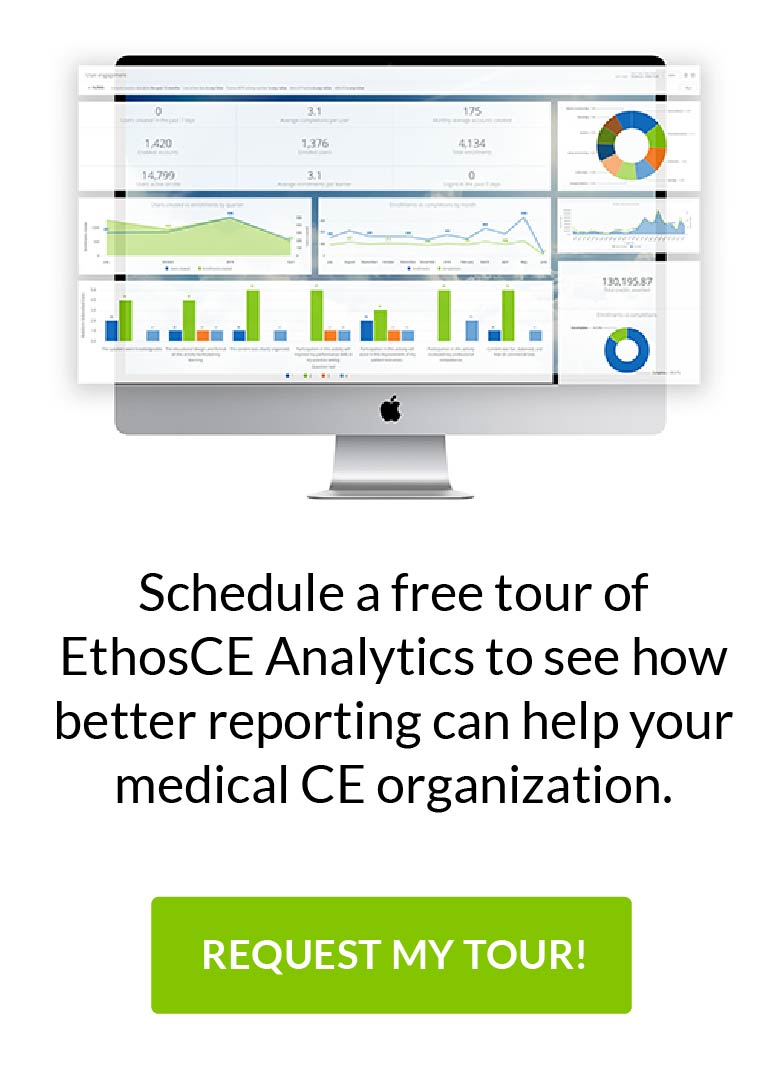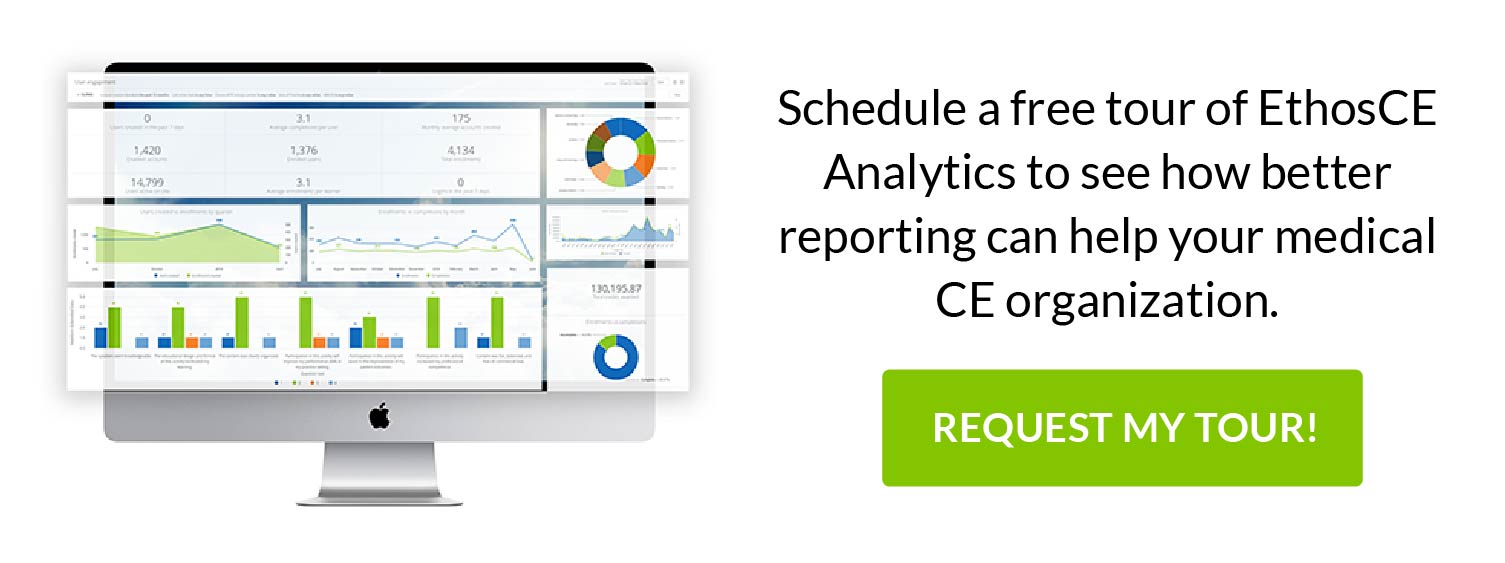How to Get Better Funding with Your Existing CME Data
Looking to get better funding for your CME program? The key may be hidden in your existing program data.
Your Data is Your 24/7 Fundraising Tool
Many CME directors don’t realize the importance of their data to efforts to get better funding for their CME programs. Whether you’re attempting to win on-going commercial support from a Fortune 500 brand or just a bigger slice of your organization’s marketing budget, you should view your program’s data as the Swiss Army knife of fundraising tools. From sharpening your funding pitch to helping outline new revenue streams for your organization, your data can serve as incontrovertible evidence of your program’s merit and potential for success.
Your program data could serve as a guide for a successful fundraising strategy—but will it? If the highlights of your program’s growth are buried in the pages of a year-end report, or if instances when benchmarks have not been met are presented without adequate context (i.e., showing the challenges that you and your team overcame to achieve your results), then your data’s value will be obscured at best.
Your program data can:
- Support your long-term projections of membership growth
- Assure transparency in the use of new funds
- Highlight your CME program’s unique value proposition
- Underscore your organization’s ability to overcome fiduciary obstacles to program success
- Present a long-range plan for the development and maintenance of competitive advantage
At EthosCE, we believe that your CME program data tells a story—one that will resonate with your potential supporters when it is presented in its entirety. That’s why we’ve made it easy to transform raw data into meaningful insights with our advanced data visualizations. With the right data, you’re empowered to create the winning narrative that will help you get better funding. Our analytics suite automates program data collection—that means no data gaps, no spreadsheet tinkering. We allow you to easily generate customized reports and media-rich data visualizations that bring your program’s highlights alive, adding visual context to anecdotal evidence and providing your potential supporters with a 360-degree vision of your program’s way forward. With advanced data visualizations, your data becomes your virtual publicist, helping you tell your story in an impactful format that can communicate pages of insights with a glance.
What’s at Stake: 3 Fast Facts on CME Funding
Whether you’re new to fundraising or a seasoned pro, you’re probably well aware that the race for CME funding is just as competitive as the battle to win the customer loyalty of the busy medical professionals whom you serve:
- Commercial support represents 27% of the total yearly revenue for the average ACCME-accredited provider.
- Advertising and exhibits income represents 16% of annual revenue for ACCME-accredited programs.
- Pharmaceutical and medical technology brands provided approximately $740 million in funds to 1,794 CME providers in 2017.
- Medical industry support of CME activities has increased in dollar value for the past four years.
- The ACCME has strict standards regarding commercial support for CME activities: your accreditation status is dependent upon your explicit and ongoing compliance with ACCME requirements.
As the number of CME providers and CME programs has grown each year since 2016, it is likely that the competition for commercial support will become even more intense in the future.
Data Due Diligence: Do You Know Which Data Matters?
As a CME director, you know that all of your core program data is important: the challenge is to know which data should be the focal point of your funding proposals.
While the specific format of your funding pitch should be tailored to each potential sponsor’s guidelines, at some point in your career you might find yourself going in “cold” without any particular directives as to the content of your proposal. Your best bet is to stick with the basics: illustrating your program’s ability to meet its challenges and innovate in response to the needs of its learners. Translation? Demonstrate your ACCME-standards compliance and a commitment to excellence with a data-rich presentation.
Use your program data to illustrate the range of your program’s CME mission, starting with inspiration for your CME program. What problem is your CME program trying to solve? Some examples of data sources may include:
- Self-identified knowledge or competency gaps presented by targeted medical professionals
- Organization-provided data that underscores these needs such as clinical data performance measures, sentinel or near-miss events, historical EHR data, claims data, or chart audits
- Root cause analysis reporting
- Patient satisfaction/HCAHPS
A data visualization is an excellent format for presenting your CME program’s origin as an evidence-driven journey: it allows you to illustrate, rather than explain, the story within your data.
Next, provide a detailed audit of your best educational outcomes, modeled after the Self Study. Have you seen a marked improvement in the performances by struggling learners? Are many of your students returning for new courses? Have you been able to address enduring concerns over limited educational resources by creating innovative curriculum solutions? Use your data liberally within your report’s anecdotes to hone in on your program’s best moments.
Finally, be transparent about what you are looking for when it comes to support. Be sure to remain with the parameters of ACCME directives in all of your communications with potential sponsors. Your report should outline clearly your intent to stay within the boundaries of ACCME standards and the mechanics of your continued compliance.
With EthosCE, your data is easily accessible from the admin dashboard. From learner performance assessments to support ticket requests, your data is at your fingertips and simple to view. You can easily view aggregate course data or look at per quiz answers from individual students. Using an automated data management system like EthosCE Analytics will take weeks of data wrangling off of your plate: that’s critical when you’re working under an application deadline.
6 Reasons to Walk Away From Your Data Collection Duties
- You don’t want dirty data. Manual data collection may compromise the accuracy of data reporting.
- You don’t have time to manage a screen full of spreadsheets. Busy CME directors need an automated method to collect and analyze program data.
- You can’t fix an invisible data gap. Missing data can’t be fixed after the fact without rewriting your report.
- You want your strategy projections to be evidence-driven and error-free. A successful funding proposal requires a comprehensive portrait of program wins based on historical and current course data.
- The most essential components of a successful funding proposal are data-driven insights: you don’t want to take any chances. Accurate course curriculum and learner outcomes data are critical elements of a professional funding proposal.
- You don’t want to hire a data scientist to slice, analyze, and summarize your data. Potential supporters will want to see extensive data summaries in addition to anecdotal evidence of the CME program’s positive impact.
Your bottom line? EthosCE Analytics simplifies data reporting and helps CME directors easily create strong funding proposals.
We offer an analytics suite that makes the creation of detailed data visualizations a matter of a few clicks, cutting down on proposal development time and eliminating human resource drain.
EthosCE clients also have an LMS that was built for scalability, along with an enterprise-grade analytics suite that offers comprehensive, automated data collection, management, and evaluation from a single dashboard.
With EthosCE, you can easily create an elegant, data-driven winning funding proposal that reflects the strength of your program and its scalability. Ready to put your data to work?
Contact EthosCE today for a 1-on-1 walkthrough on how you can utilize your existing data to receive the funding you need.
 We're now part of the Cadmium product suite! Learn more
We're now part of the Cadmium product suite! Learn more 

